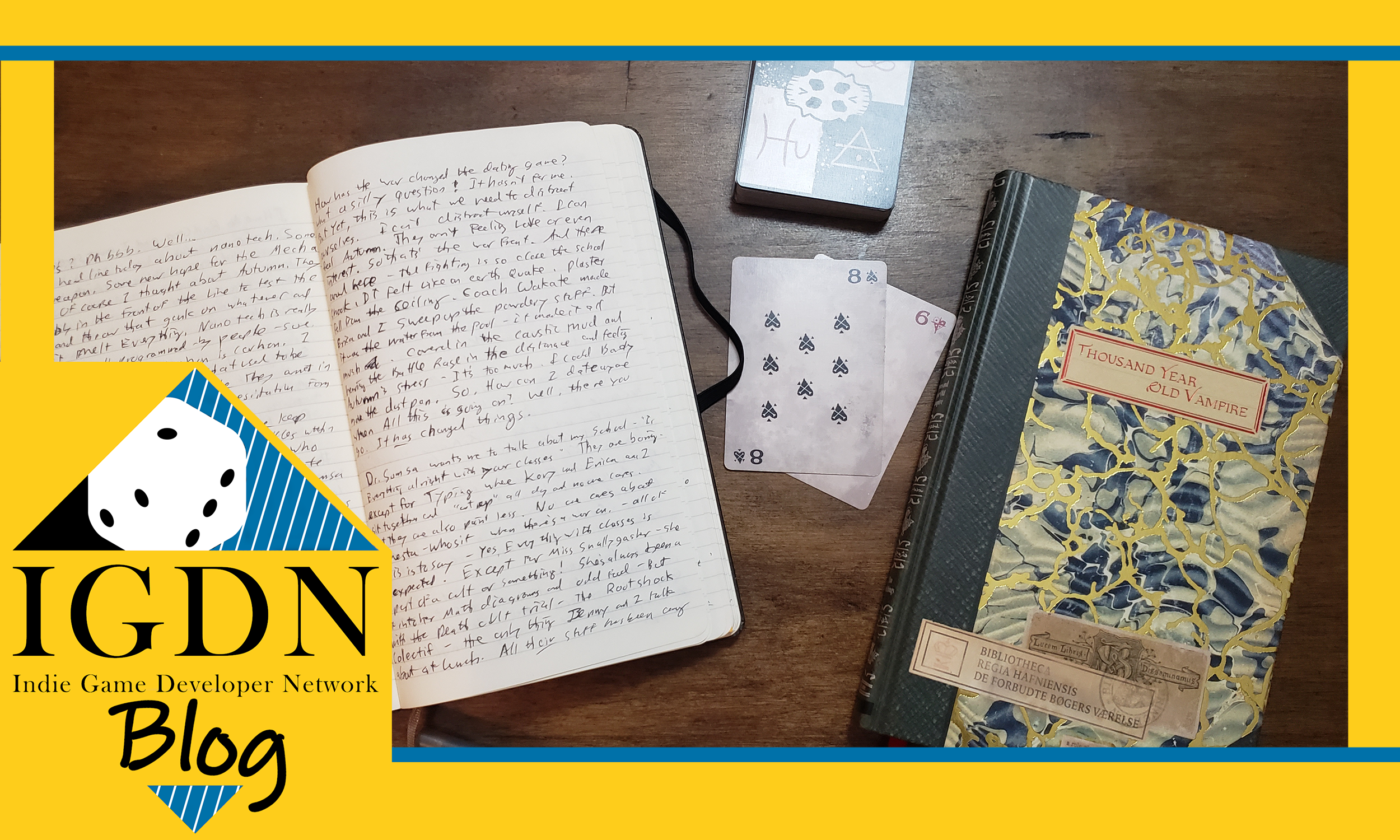In Praise of Solo Games
In Praise of Solo Games
Make Small Games for Fun
Matthew Orr
This article is part of the Indie Game Developer Network's blog series. The opinions and views expressed in this article are those of the author and do not necessarily reflect the opinions and views of the IGDN or its members.
In 2023 I decided to play solo games as part of my morning routine. A cup of coffee and spinning some worlds has been a nice way to start the day. Some of the ones I’ve played have been quite small like Oliver Darkshire’s one page roll and write games. Others have been sizable, like Shawn Tomkin’s Ironsworn. After playing these games, I am narrowing in on what makes a perfect solo play experience for me. In the second part of these short series, I’d like to point out a few of the aspects of solo games I’ve seen and enjoyed.
Make the Character
Making a character, a role to play, is a key part of a solo roleplaying game. In many cases you will be playing the only significant character in the story, so your character becomes all the more important. I like a game that sets up who I am and what I am doing in an interesting way. The specific subset of all possible elements a game puts forward as part of the character highlights what the game is going to be about. In Kyle Tam’s Beloved you craft a child’s toy to guide children through life’s troubles. In Alex Rinehart’s Today’s Passing you explore a character over several branching versions of their life. I enjoy how these explorations of character can be more internal, more esoteric, and often more intense than if you had to also interact with other players playing other characters.
Expand the Prompts
I have kept a journal since I was a teenager—so a daily writing practice is something that is not a stretch for me at all. Thus, for me, a journaling element to a solo game is something I really enjoy. A fair few solo games are almost entirely journaling. Maybe some dice rolls, a few questions for a character sheet, mostly choosing what to write about. Once I have a character, answering questions about what happens and describing how I feel, to the page—in character—is something I enjoy. The ideal experience for me is a game which balances the world of the game the creator has made (as revealed in the prompts) with the ability for me to act freely in that world (through the journal). If the genre table-setting and scope of play has been laid out at the start, I am very willing to play along and nestle into the experience of whatever events come next. I found Meghan Cross’ Sentinel did this well. There’s a lot of latitude to make up what my immortal sentinel does and looks like, but the prompts to add new threats and reveal old memories never conflicted with what I’d already imagined. This is also true of Jacqueline Bryk’s I Have No Railgun and I Must Scream. It’s a war between giant monsters and teens in giant robots. You are not one of those teens, but your sibling is. You stay at home and hear about the war (a deck of playing cards reveals the day’s headline). The prompts are constantly revealing the wider world in stages, but since you are on the homefront, you have the freedom to write about how you feel about the news. It was a perfect balance for me.
Draw the Map
If exploration is part of the game, there is often a map. Or, more likely, I am invited to make one. In Anna Blackwell’s sci-fi exploration game Umbra and Dan Bronson-Lowe’s Librarian’s Apprentice creating the map as you go is a key part of the play. In Umbra you explore an alien planet square by square and use grid paper to diagram your expanding base. A playing card deck tells you what you find in each square initially, but you can build new modules as well, changing the map as you go. In Librarian’s Apprentice you draw playing cards and place them on the table as you move from room to room to map the library. The books you are looking for are in rooms with face cards, but each room creates an encounter you have to survive first. Map-making is about creation of a world and discovery. It’s fun to have the tension of the unknown. What will be in this next part of the map? Will it be good? Let’s check the table!
Mark the Record
Not every game is strongly focused on the creation of a journal or a map. Some very good games happen almost entirely on the character sheet. The stand-out here is Craig Campbell and Sharene Gilchrist’s Secrets of the Vibrant Isle. The random encounters in Secrets are about checking your attributes, rolling for success or failure, then managing your inventory. I appreciate how finely crafted the game is and how the skills and equipment play such a major part of what you are doing. Another great solo game with a more numbers sort of approach is Alan Bahr’s By Endurance We Conquer, a South Pole expedition simulator in a deck of cards. Fudge dice and a spread of cards show you what the day’s march will be like. It’s all resource management and risk mitigation which creates the feeling of slow, deadly progress across a dangerous landscape. When the puzzle part of these games is combined with a well-designed sheet to navigate the play, I appreciate the craft of it.
Follow the Arc
Some of the solo games I’ve played can theoretically go on forever. But I appreciate a game that has a set arc or a set time line. This adds stakes and in-game pressure to finish the story. Even if the stakes are low, having a set amount of time to play is great for creating a satisfying story where you can set up your own beginning, middle, and end. In Adam Vass’ Sleepless Seas, you are tracking the days through one cycle of the moon. Travel takes time, and the world gets weirder as the weeks go on. The end is coming and you can incorporate all that into your journal entries. In Tim Hutchings’ Thousand Year Old Vampire there are only 90 numbered prompts and you move forward and backward through the prompts based on dice rolls, but mostly you advance forward to one of the final prompts, all of which end the game. I enjoy the feeling of getting to the end of one of these games, leaning back, and thinking “that was good.”
That’s what I like about playing solo games. I like most the games which offer a tool set to create an interesting and transporting experience. It’s a story in my mind, but it is made through the process of thinking of what to write, draw, or check off and then actually writing down the outcome of those choices. Playing these games and taking note of what I like about them has been an education as well as enjoyment. So now, I turn my attention to creating my own solo games.
This IGDN blog article is brought to you by Matthew Orr, Creative Director of Wet Ink Games. If you want to get in touch with the contributor they can be reached at wetinkmatt@gmail.com or visit their website at wetinkgames.com.

